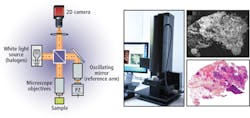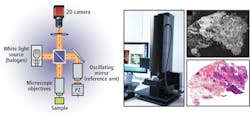Medical Imaging: Endoscope employs custom camera for in-vivo cancer detection
Early cancer detection is often performed by removing tissue from a patient during a biopsy procedure and then examining the cell structure under a microscope. Identifying which tissue to be removed, however, is not an exact science and patients often need to return for a second biopsy. Since this procedure is both painful and expensive, the ability to ensure the correct tissue is removed speeds the diagnostic procedure while reducing patient stress and expense.
To increase the certainty of obtaining cancerous tissue, LLTech (Paris, France; www.lltechimaging.com) is developing a hand-held rigid endoscope that provides surgeons and pathologists to image tissue at the cellular level. With expertise in Full Field Optical Coherence Tomography (FFOCT), LLTech has adapted this technology in the hand held-device. FFOCT is a high resolution time domain OCT technique, usually based on a Linnik interferometer in which the sample is illuminated by a low-coherence light source such as a halogen bulb. Unlike other time domain or frequency domain OCT techniques, it does not make use of any scanning device to build an image, which results in increased acquisition speed and instrumental simplicity.
Light reflected from the sample interferes with light from the reference arm to produce an interference pattern. By sinusoidal modulation of the path length of the reference arm using a piezo-electric transducer, the interference pattern will also be modulated sinusoidally. Then, a linear combination of at least 2 interference patterns results in a grey-scale image of a 1 micron thick slice of the sample, thus revealing tissue microstructures at a cellular scale, without the need for any tissue modification, staining or slicing.
Previously, LLTech has used this technology in its Light-CT Scanner, a FFOCT microscope that enables volumetric image capture on tissue samples at a resolution of about 1 micron. To build 3D images, the Z-stage of the Linnik interferometer is successively moved such that multiple 2D images from microstructures are captured and then reconstructed in 3D. Such a device provides images of morphology and microstructures of excised tissue within minutes using a non-invasive, non-destructive process.
"One of the major challenges in developing such a handheld imager," says Fabrice Harms, CTO of LLTech, "is capturing images at very high-speed while maintaining a good contrast. This is necessary since any motion of the patient or surgeon will severely impact the quality of images obtained."
To overcome these challenges, LLTech turned to CMOSIS (Antwerp, Belgium; www.cmosis.com) to develop a custom 1440 x 1440 CMOS custom imager. With 12 x 12 um pixels, the CMOS imager is capable of running at over 700 fps at 10 bits/per pixel. "Unlike other CMOS imagers," says Harms, "the full well capacity of the imager is approximately 1.6 million electrons/per pixel, which will significantly enhance the sensitivity of FFOCT".
With its high-speed, shot noise limited behavior and linear response, the high dynamic range imager enables the detection of small signal variations in bright images while allowing such images to be captured at high-speed. Using this imager, Adimec (Eindhoven, The Netherlands; www.adimec.com) built a modular embedded camera based on the imager for LLTech. With a CoaXPress (CXP) interface, this camera is then used to transfer images from the endoscope to a PC-based Radient eV-CXP frame grabber from Matrox Imaging (Dorval, QC, Canada; www.matrox.com).
Once successive interference images are obtained, image computation is performed on the host PC to render the final image of the tissue. To use the endoscope, the surgeon places the tip of the probe onto the tissue to be measured. This allows 2D images to be captured from the tissue at depths between 20-100 microns, depending on the optics used. "Because the spatial resolution of these images is one micron, tissue microstructures such as vessels, glands or individual cells that measure 5-10 micron in diameter can be imaged. This resolution is currently not possible with other OCT-based techniques" says Harms.
This development has received funding from the European Union Seventh Framework Program FP7-ICT-2011-8 under grant agreement 318729.

